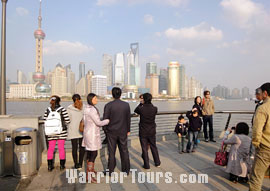Huangpu River & the Bund

![]() Huangpu River
Huangpu River
The 'mother river' of Shanghai, the Huangpu River is the symbol and embodiment of Shanghai, just like the Thames of London, the Seine of Paris and the Danube of Budapest. This river is synonymous with the History of Shanghai, being inextricably intertwined with the social and economic life of the city and having nurtured its prosperity and witnessed its honors and disgraces. The Huangpu River is a must for travelers to Shanghai.
The Huangpu River, one of the earliest rivers in China to be dredged by man, originates at Dianshan Lake, in the Qingpu District of Shanghai, and finally flows into the Yangtze River at Wusong Estuary. It is 114 kilometers (71 miles) long, and 400 meters (0.25 miles) wide, with an average depth of nine meters (30 feet). Flowing through the hundred-li (31 miles) harbor district of Shanghai, the Huangpu River is the biggest river in Shanghai. The Shanghai section qualifies as one of the first-class waterways of China, allowing ships in the three to ten thousand ton class to navigate it. Affected by the tidal Yangtze River and the East Sea, the water level of the Huangpu River fluctuates markedly during the year. The flood season can last from May to October, while December to February is its low-flow period.
The Huangpu River divides Shanghai into two parts – east and west. Sailing down the river, you can enjoy the beautiful scenery on both sides including such sights as the Yangpu Bridge, the Nanpu Bridge, and the Oriental Pearl TV Tower. In addition, the varied western architecture on the west bank of the Huangpu River and the towering modern buildings on the east bank present a spectacular contrast, increasing the beauty and magnificence of the river.
At night, when bright lights light up the architecture along both banks, the Huangpu River is a beautiful and enchanting sight.
Wusong Estuary is the meeting place of the Huangpu River, the Yangtze River and the East Sea. The water of the Huangpu River is a greyish blue after flowing through Shanghai, the water the Yangtze River contributes is yellow, and the water of the East Sea is green. Thus, every time when the tide is high in Wusong Estuary, it is possible to view what is known as the wonder of 'Three-ply Water'.
![]() The Bund
The Bund
According to the custom of place names in Shanghai, the upstream of a river is named 'li' (inner), and the downstream is called 'wai' (outer). The Huangpu River forms a blind bend at Lujiabang, at which point the local dwellers named the upstream of the Huangpu River as 'the Inner Huangpu' and the downstream 'the Outer Huangpu'. Correspondingly, the banks are named the inner Huangpu bank and the outer Huangpu bank. The outer Huangpu bank is also known as 'the Bund'.
Originally, the Bund was a center for foreign trade, where foreign firms were numerous. From the end of the 19th century, many foreign and Chinese banks were built on the Bund, turning it into a 'finance street' also known as 'Eastern Wall Street'. Thereafter, the Bund became very valuable land and a sought after location. Bankers and businessmen from various countries congregated along the Bund, constructing their offices and headquarters on a large-scale. Architects from different countries took the opportunity to display their courage and skill on the Bund, and soon over 20 major buildings with distinctive architectural styles sprang up, hence the Bund also enjoys fame as a 'Museum of International Architecture'.
The Bund is also called Zhongshan Road, and has a total length of 1.5 kilometers. It has always been the center of Shanghai's political, economic, financial, business and cultural life. Most foreign consulates, banks, businesses and newspaper offices are located here. The Bund starts at the Baidu Bridge over the Suzhou Creek to the north and ends at East Jinling Road in the south. Altogether 52 various buildings of different architectural styles stand along it, including Gothic, Baroque, Romanesque, Classical and Renaissance. Although these buildings were designed by different architects and built at different times, together they form an impressive architectural pattern.
Walking along the Bund, the Bank of China Building, the Peace Hotel, the Customs Building as well as the Hong Kong & Shanghai Banking Corporation will take you back to the 'Wall Street of the Far East' of former days. At the same time, you can also catch a glimpse of many other famous, important and magnificent buildings on the Bund such as the Building for Investment Inviting Bureau, the Mercantile Bank of India, London & China, the Asia Building, China Merchants Bank Building and the British Consulate Building.
|
Admission Fee:
|
Free; Bund Sightseeing Tunnel: CNY 45 for one way; CNY 55 for round trip
|
|
Opening Times:
|
09:10 to 22:00
|
|
Bus Route:
|
20, 22, 37, 42, 55, 65, 71, 123, 503, 126, 127, 135, 145, 934, 251, 940, 576, 831, 868, 910, 921, 926, 928
|

